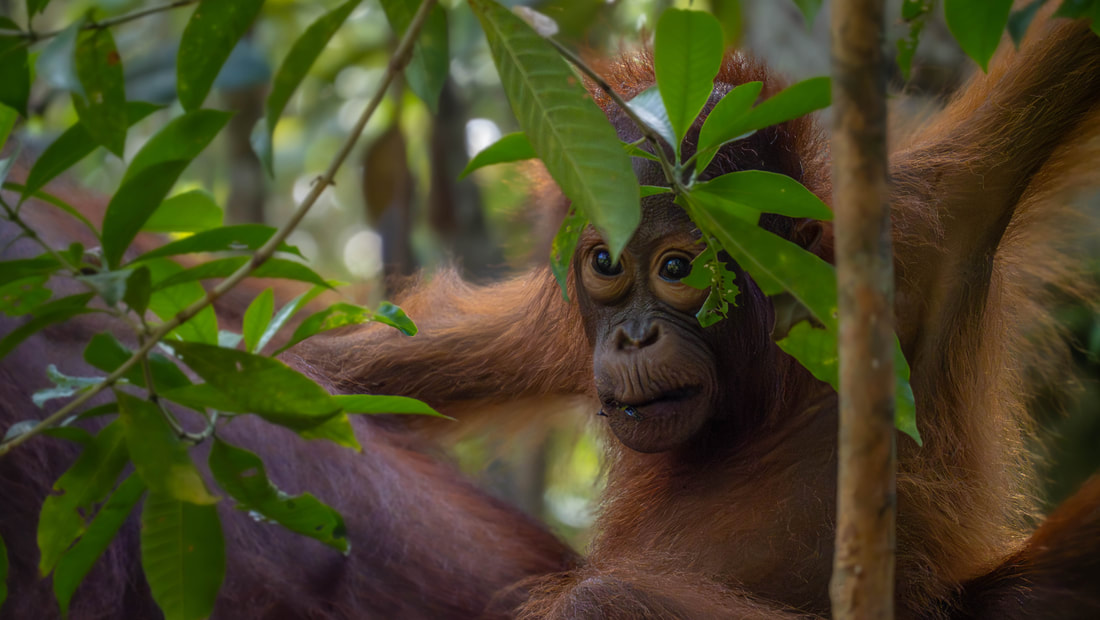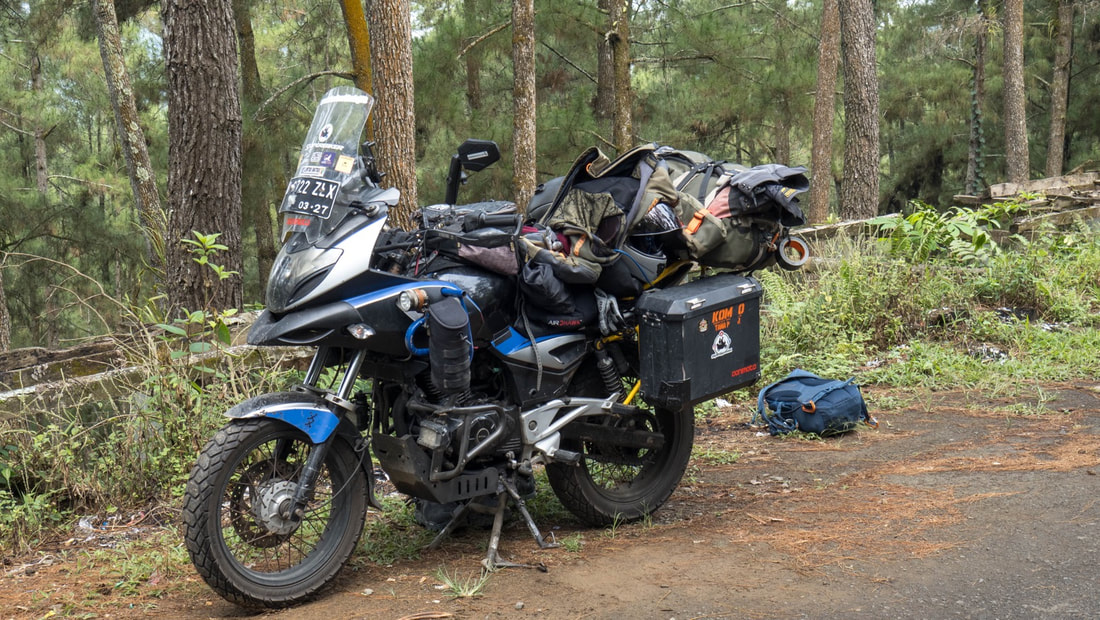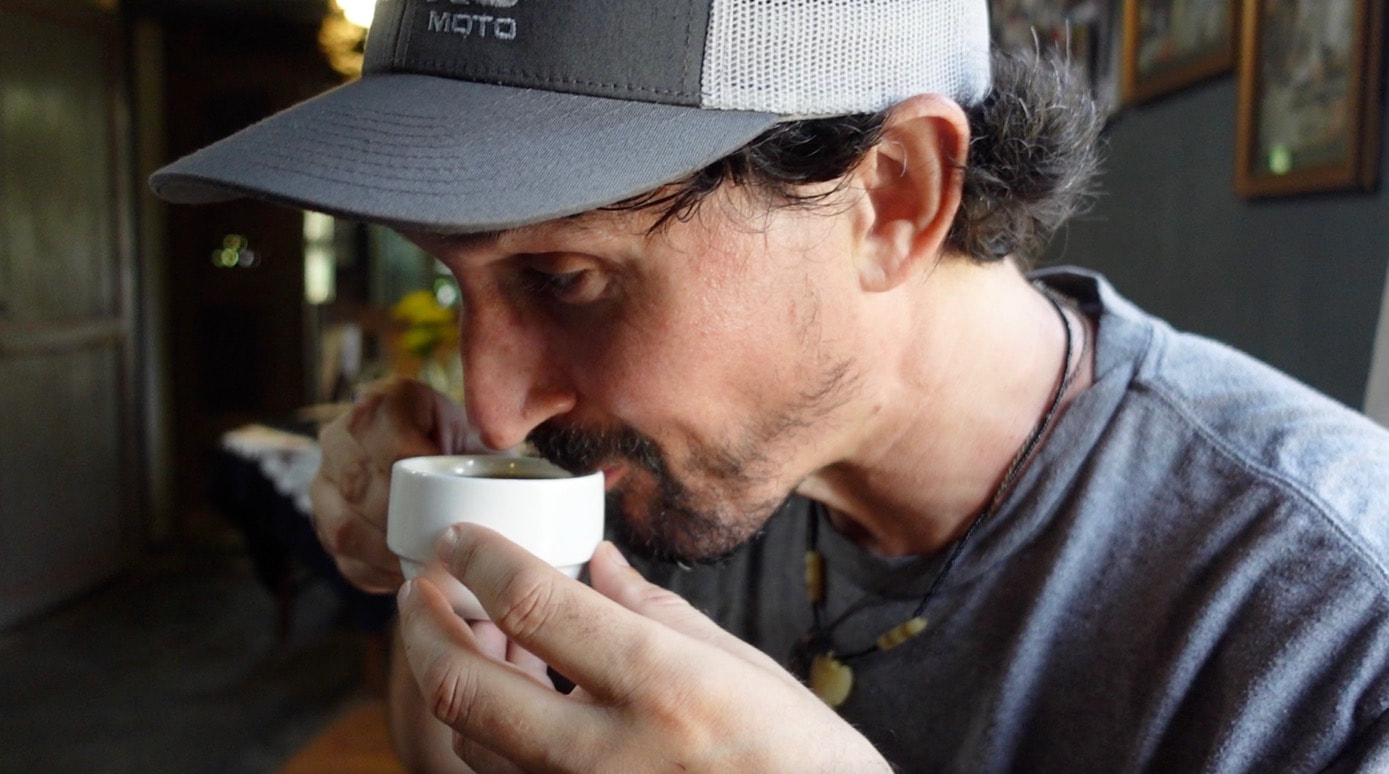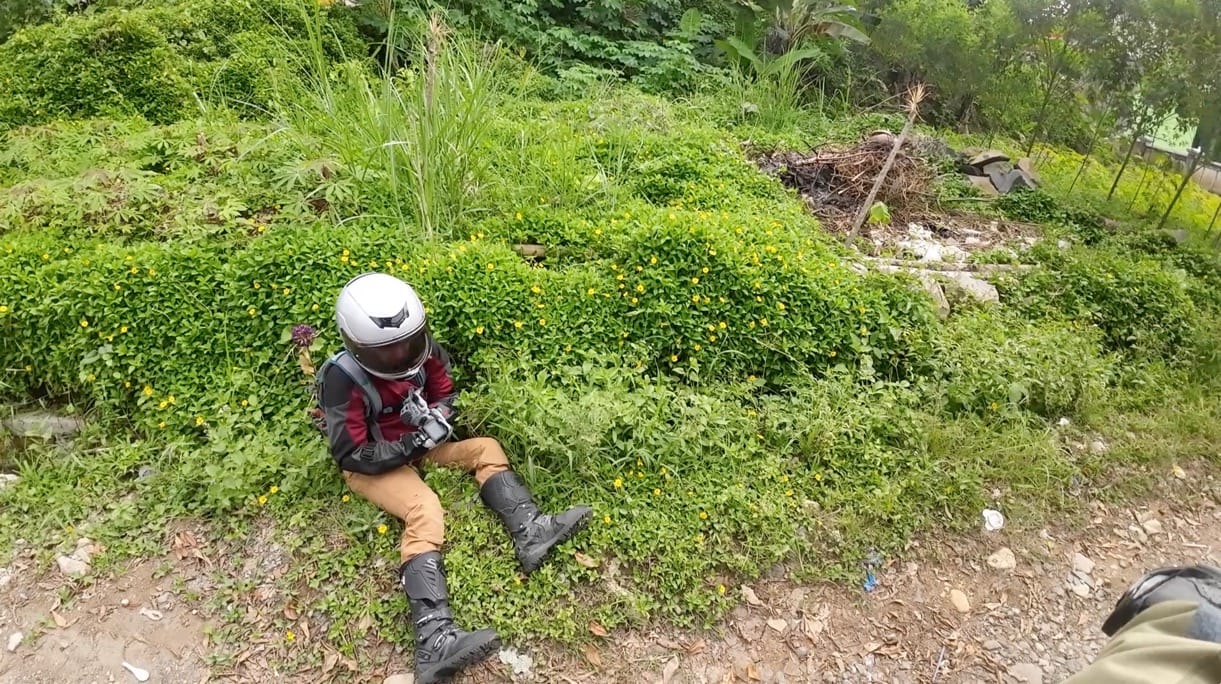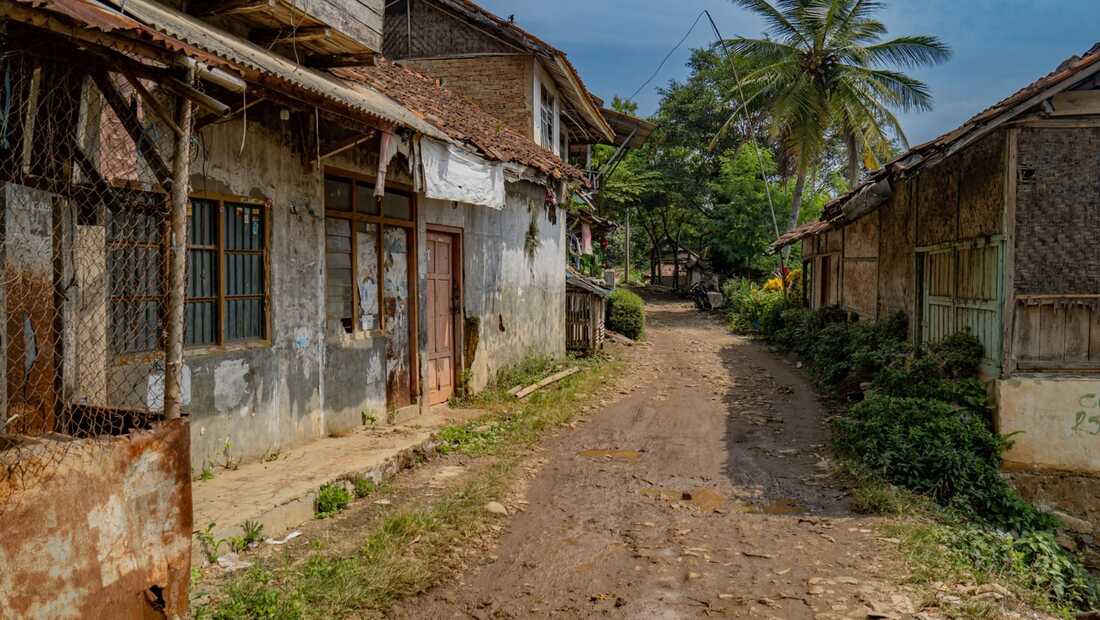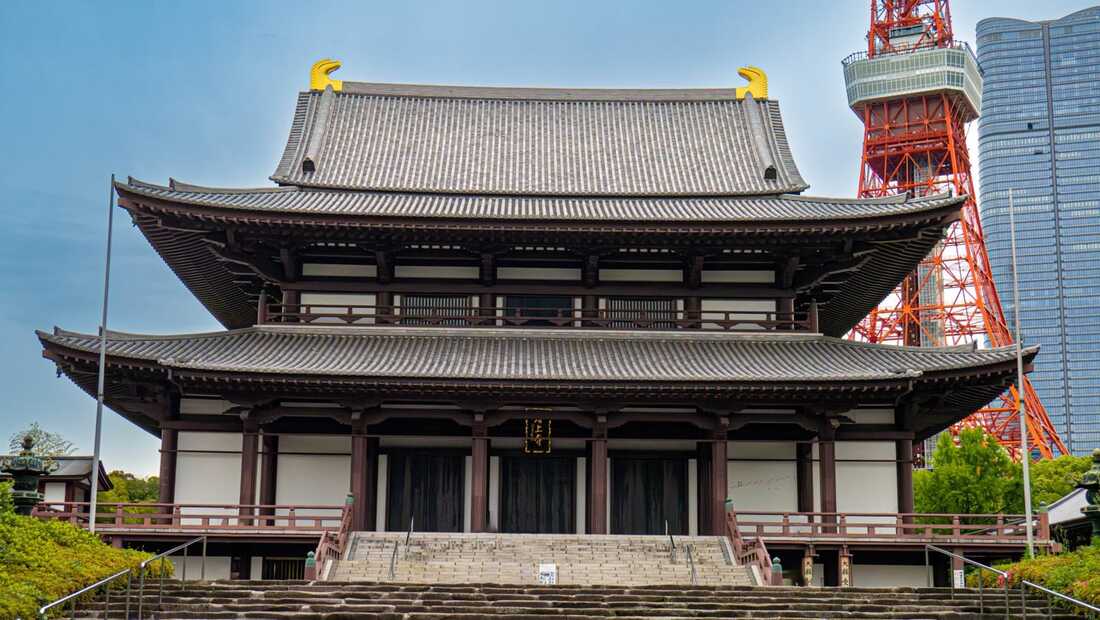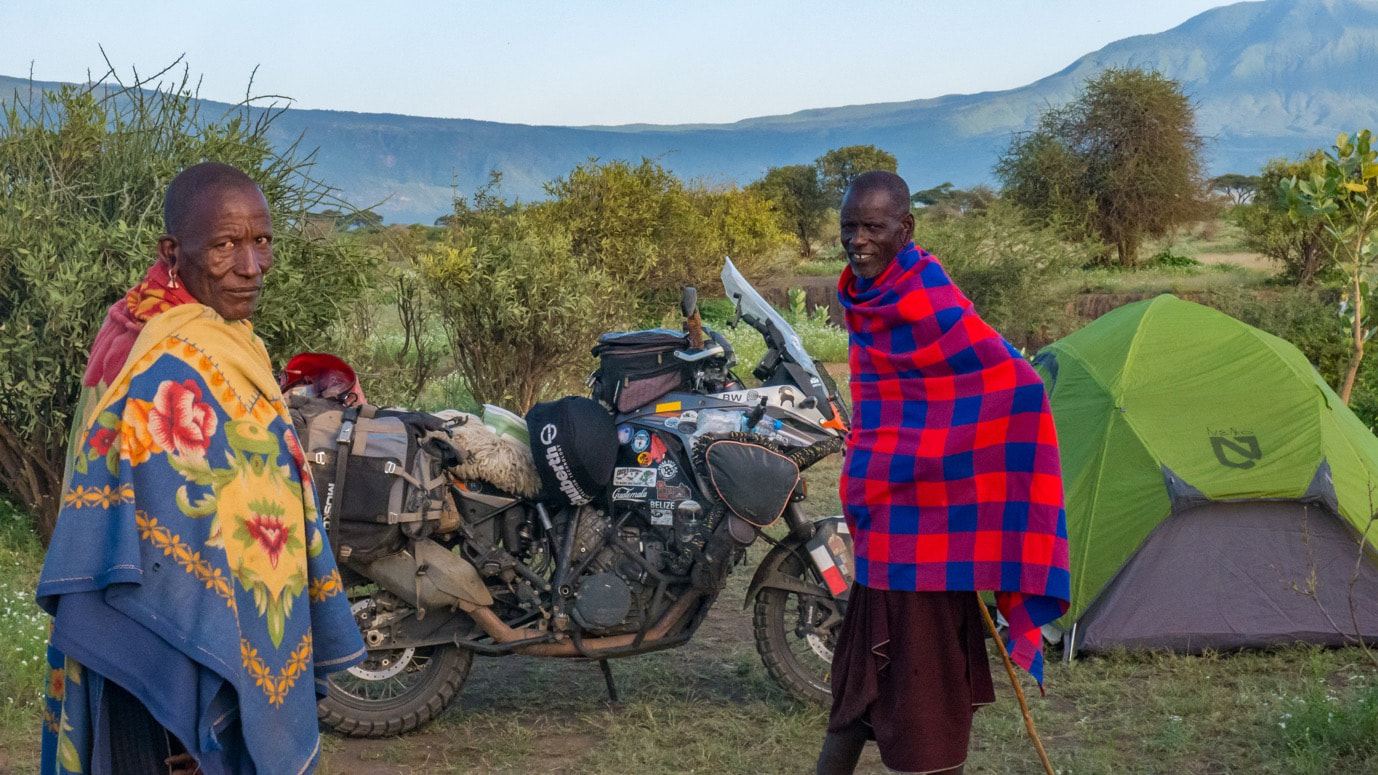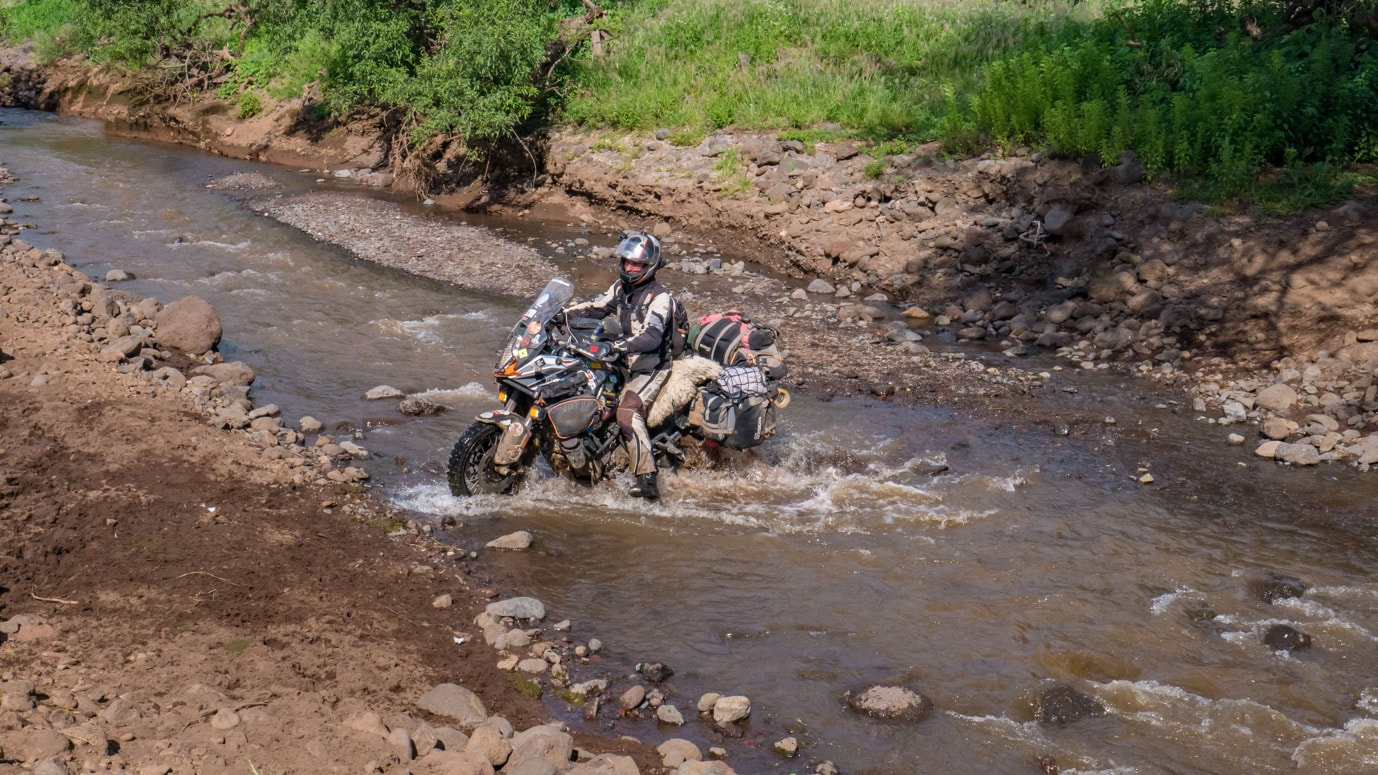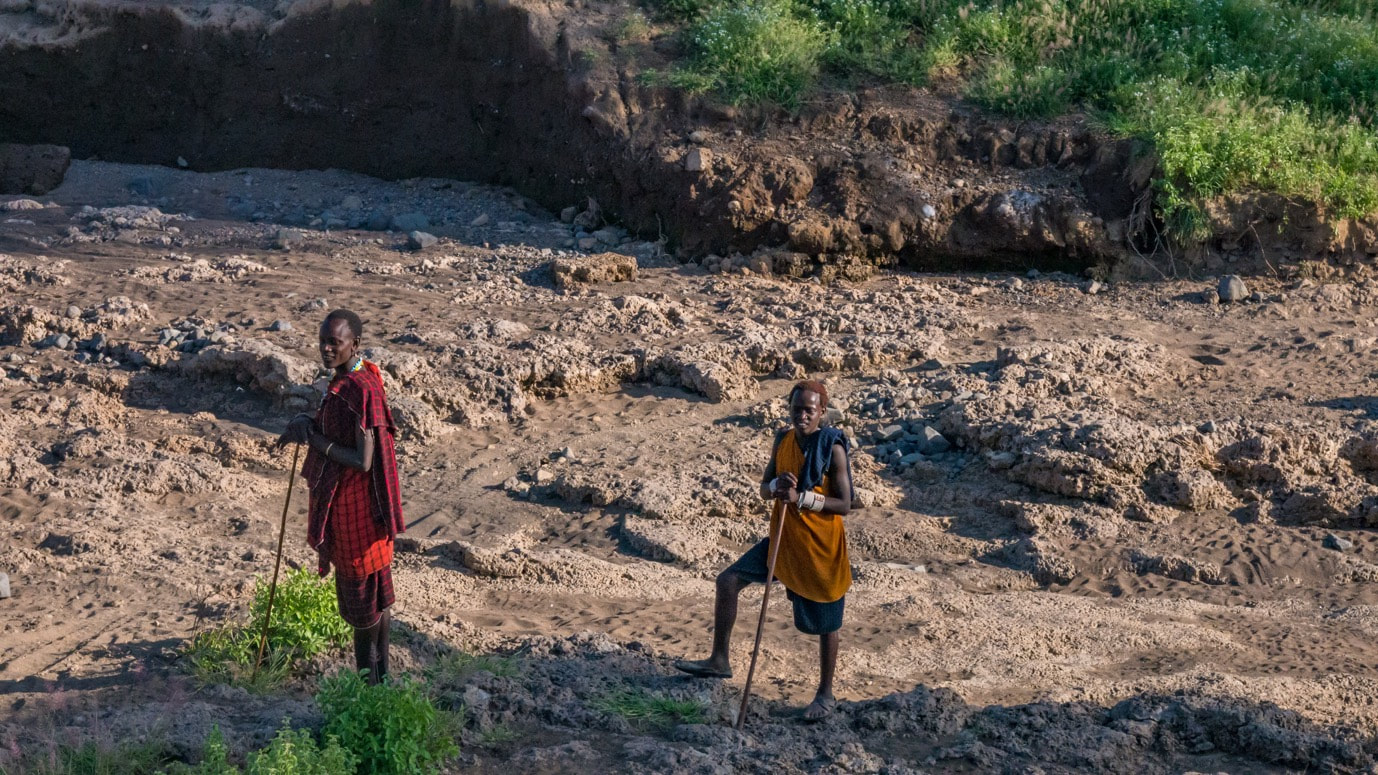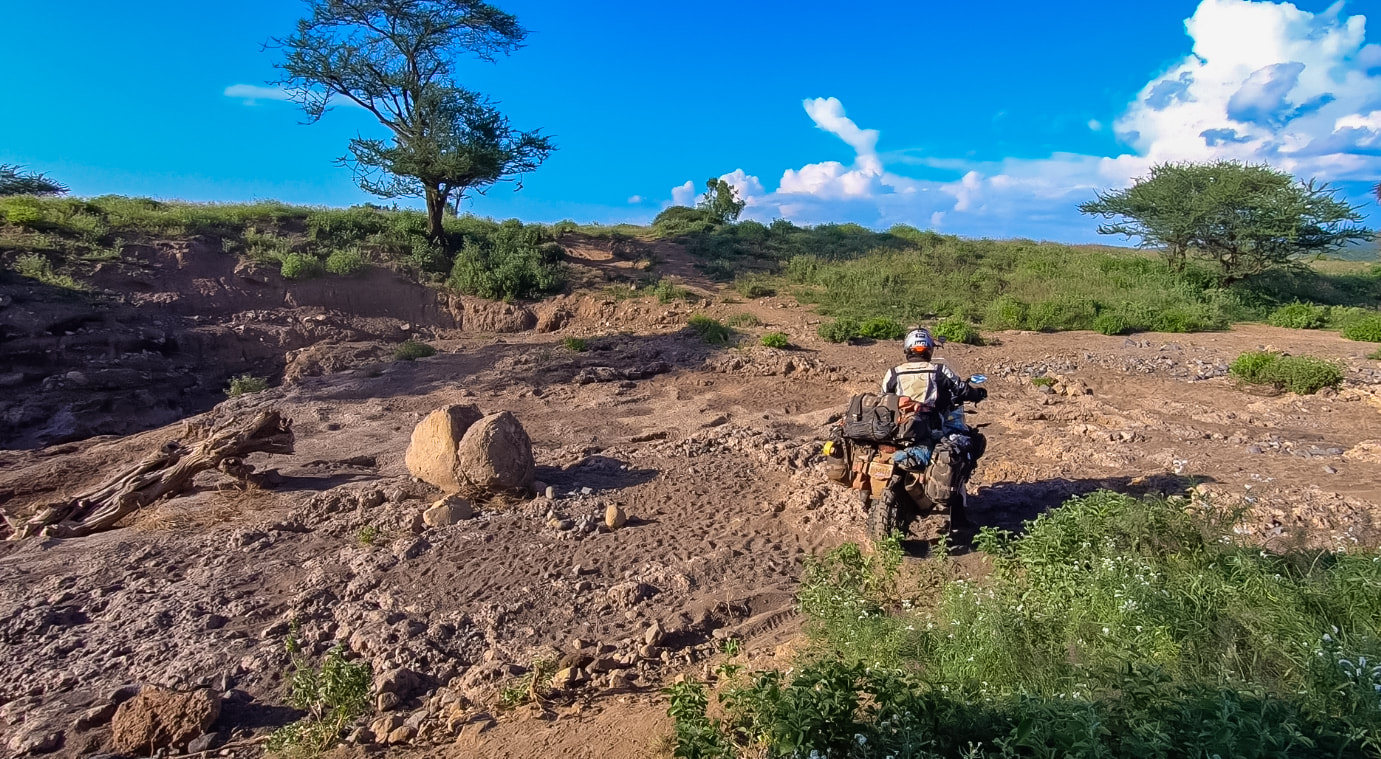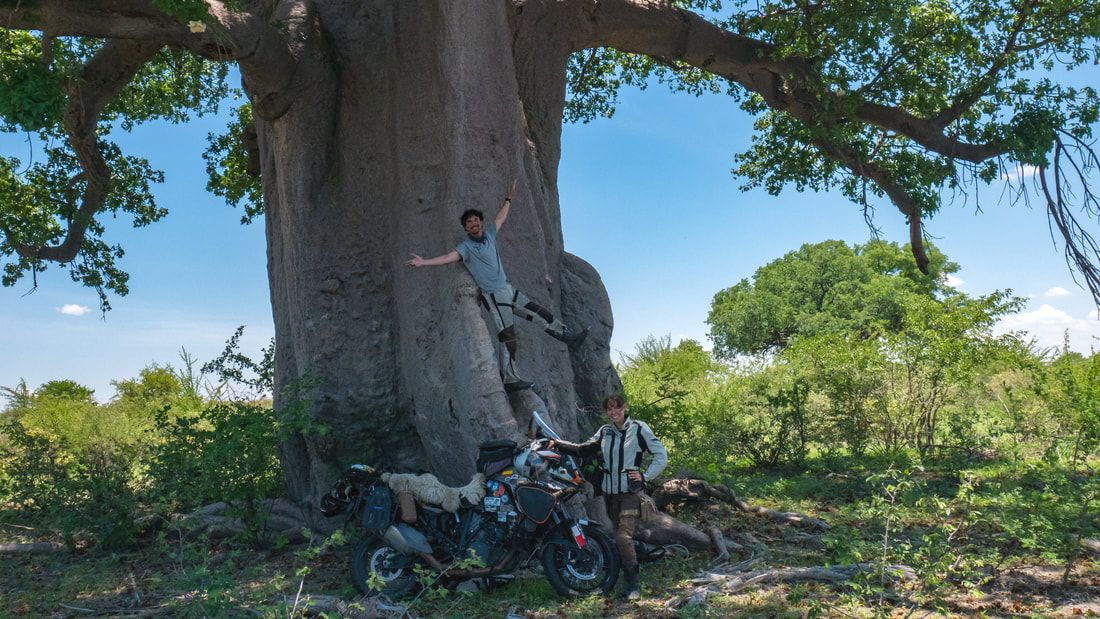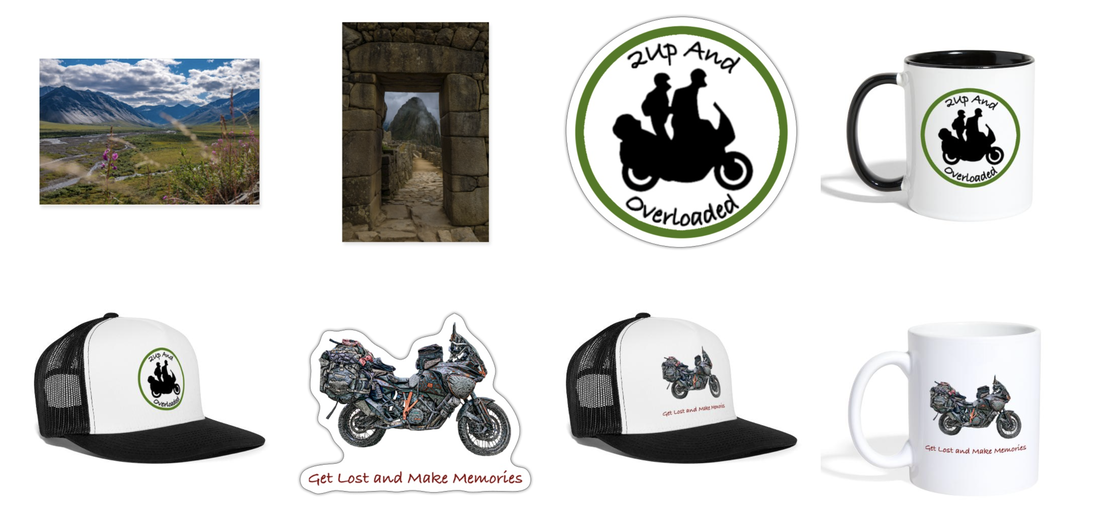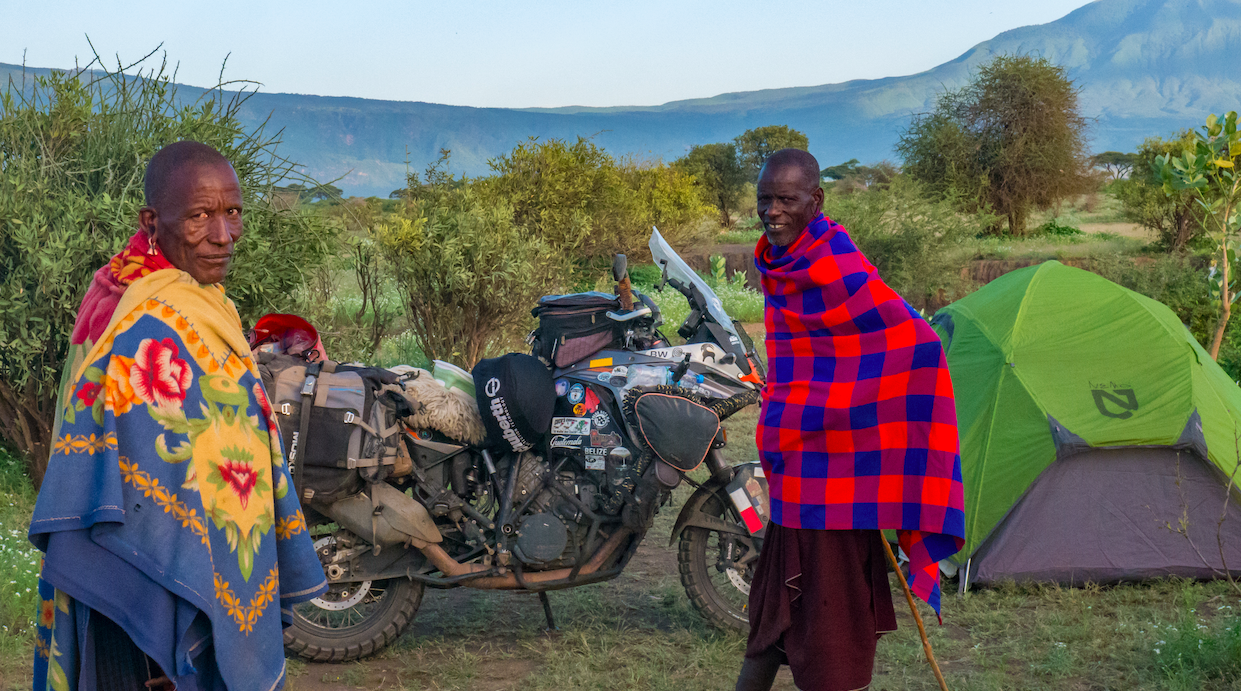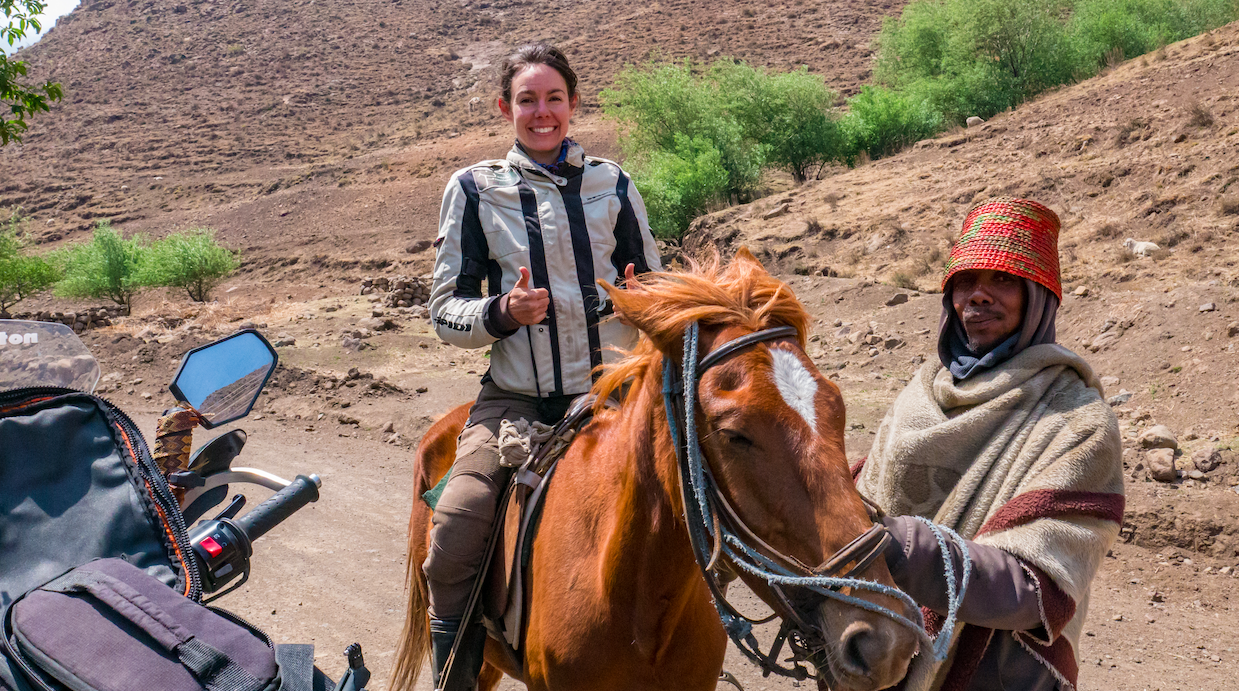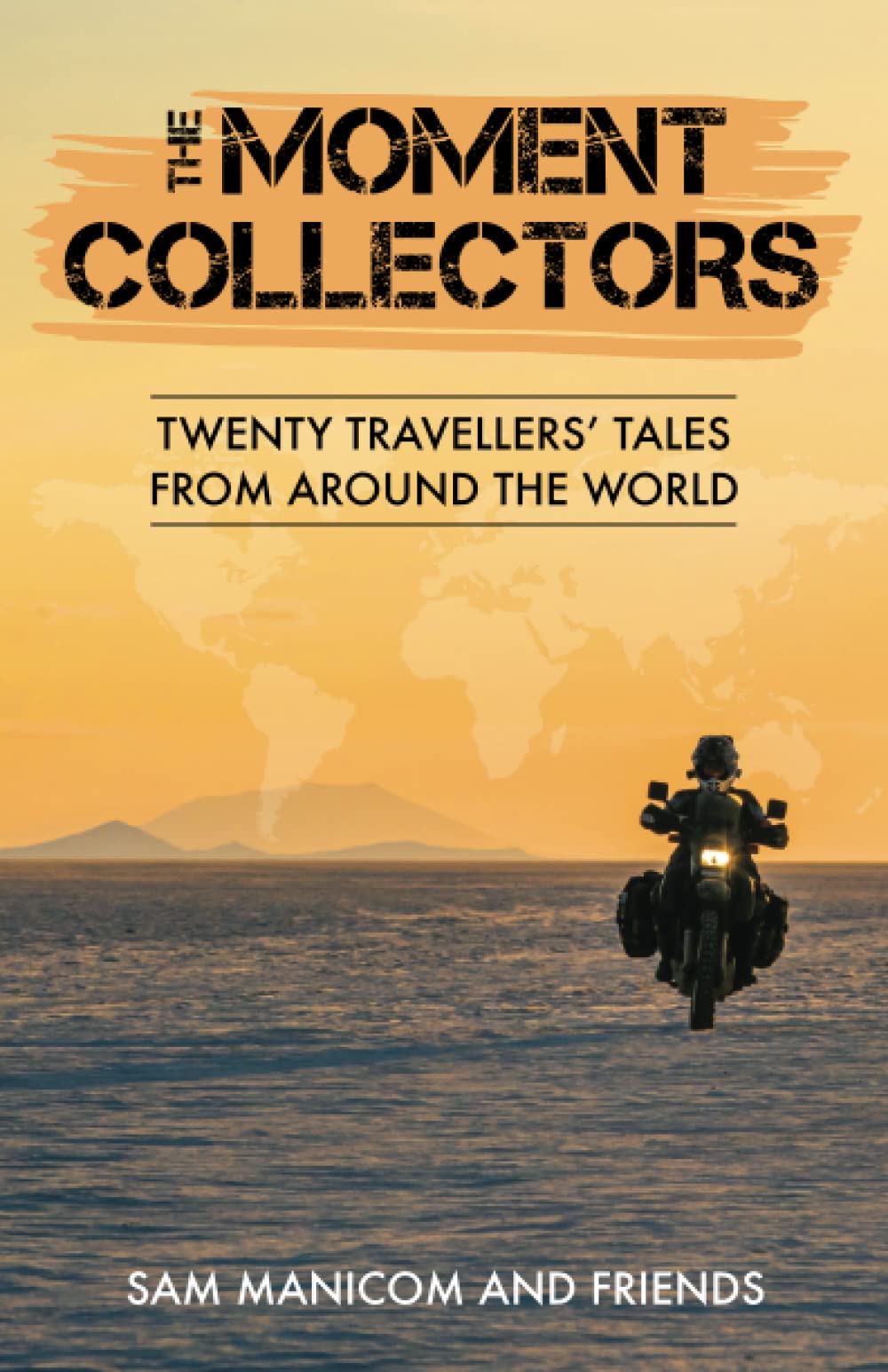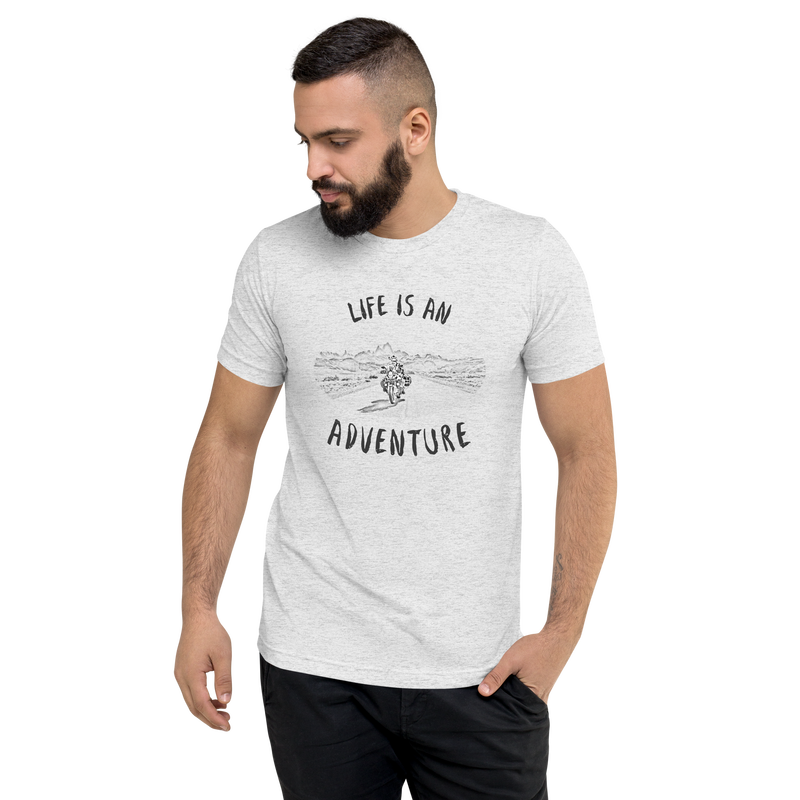By Marisa and Tim NotierWe arrived by ferry to Kumai, Indonesia, known as the springboard to the dense jungles of this wild island of Borneo. And we soon learned that the only way to really access the jungle is to take a boat into it via a system of rivers. There are no roads through the jungle, because this is one of the last, pure, untouched wildernesses of the world. And so that is what we decided to do, hire a boat that would take us into the heart of the forest. Because apparently, there is a mysterious creature that lives in this intense wilderness and nowhere else on earth. Larger and stronger than a man, some say they are just as wise as humans, with eyes that see straight to the soul. They are orang-utans, and we were on the path to finding them in the wild. Our boat arrived at our first stop on our voyage, and that was the Tanjung Harapan research station where a feeding was going to take place. There is never any guarantee of seeing a wild orangutan, but in order to research them, these scientific stations had regular feeding schedules of orangutans, and so we were going to see if any showed up that day. And then, just a few feet down the path to the feeding place, we saw one! It was a mother and her child, and she was making her way to the research station. As they started to move towards the feeding area, we did as well. And I was immediately consumed by the beauty and sounds of the jungle. And mosquitoes. We arrived at a small clearing where there were crude benches for us to sit on placed at a distance from a wooden platform where they were to put the food for the orangutans. A bunch of tourists were already there waiting, but we got good spots, and then waited for the great apes to arrive. And what do they feed orangutans? Bananas! Which makes sense since bananas are from this region. Right when the workers put out the first bananas, a large male showed up, followed by a mother and her baby. It was amazing to be able to watch them eat so closely. Their colors, the way they ate, the shyness that they had for being watched, the peacefulness of their demeanors, the way the babies clung onto the mothers, the fuzziness of them, it was all so amazing. Orangutans have a lot of similarities to humans. They are part of the great ape family that includes gorillas, chimpanzees, and modern humans. They even share more then 97% of their DNA with humans. They grow to be between 4-5 feet tall, which is pretty tall for an ape that lives in the trees, and also weighs between 70-165 pounds. In fact, they are the largest tree-dwelling animal on earth. Fun fact brought to our attention from one of our YouTube subscribers, @JagLite DNA Genetic Similarities: Humans and Humans 99.9% Humans and Chimps 98.8% Humans and Dogs 94% Humans and Cats 90% Humans and Cows 80% Humans and Fruit Flies 60% Humans and Bananas 60% I am somehow comforted by the fact that I (Tim) am 90% cat... Orangutans make beds in the trees to sleep in using leaves and twigs. Sometimes they'll also make a roof-like structure for when it rains. They are mostly vegetarian, eating fruits and leaves, bark, nuts, bird eggs, and insects. The males grow these large facial extrusions as they age. And the females will keep their baby with them for up to 8 years! That means they only give birth every 8 years as well, and this is the longest time between births of any land dwelling animal. That's a remarkably long time for the the mother to raise her baby, and shows how similar orangutans are to humans. Orangutans are considered one of the most intelligent of primates. They have been known to use tools for food foraging, river crossings, and even will use leaves against their mouths to amplify their calls. They've also been shown to have self-awareness in a mirror test. But as night descended on the forest, we began to prepare for our first night deep within one of the most remote and dangerous jungles on earth. And to the gorgeous sounds of the forest, we went to sleep. The next morning was pure magic! The sounds of the morning were unbelievable. It was one of the most peaceful and incredible mornings of my life. If every morning was like that… wow. How perfect life would be. Eventually, we got the engines going, and headed off to our next orangutan research station in the jungle - Pondok Tangui. Rizal, our guide, told us the story of the elusive Jacob, the largest male orangutan of the region. He showed us pictures that he had taken of Jacob - King of the Jungle. But since Rizal had only seen him a few times on the many tours that he gave, he told us that we were probably not going to catch sight of Jacob. But along the way, we did see more proboscis monkeys with their ultra large and incredible noses. At the next research station, Pondok Tangui, we had a beautiful forest walk, and once we got to the feeding station, a new type of monkey showed up to get first dibs of the bananas - macaques. They were everywhere! But then the orangutans once again stole the show! After another amazing showcase of nature, we headed back on the boat and followed the river down an even smaller tributary. We were going as deep into the jungle as the boats can go, to the very beginning of the river's source at the last camp, called Camp Leakey. Pulling into Camp Leakey was a traffic jam of boats. We had to wait a while before we could get off. It's a popular site for tourists because this is the first orangutan research station built in 1971 when Dr. Galdikas and her former husband Rod Brindamour journeyed into one of the last truly wild and unexplored places on earth. They established Camp Leakey named after Dr. Galdikas's mentor. At the time, the nearest place with supplies was twelve hours away by paddling in a canoe. They lived in a bark walled hut and suffered from malaria, dengue, tropical ulcers on their legs, and leech bites. But they did some groundbreaking research on orangutans. Today the site is still an active research station and is the site of the longest continuous study of orangutans in the world. But as we were walking to Camp Leakey, we heard some rustling in the trees... And then… High up in the branches we saw… Jacob!!! King of the Jungle! He was HUGE! There was also a gibbon, which we had not seen yet. So now we'd seen all the major types of monkeys in this forest and we were simply brimming over with happiness for the good luck that we'd had. And just as the workers put out the bananas, Jacob arrived! HUGE! He had very large facial protrusions, distinguishing him from the other orangutans. But he was surprisingly shy for such a big guy. He seemed to be in harmony with the others, like any good king should be. Soon there were orangutans everywhere. Looking up in the trees, you could definitely see why they were called "people of the forest." But then as we were leaving, Jacob started heading down the same trail as us! And we got face to face with the King of the Jungle. It was breathtaking and bit scary to be honest. Marisa and I felt so lucky that we were able to gain so many wonderful memories in those two days on our magical river tour. We had met the "people of the forest," and their king, we had seen the mischievous macaques, and the long armed gibbons. We truly felt satisfied and humbled. As our river boat tour came to an end, we had to head back to the hotel. Though great voyage into the jungle of Borneo by boat was over, our great voyage into the jungle of Borneo by motorcycle was about to begin. To dive further down the river into the jungle with us, check out our 3 YouTube episodes we made that cover all of the wonders we experienced!
And we want to say THANK YOU to all of our Patrons!! We are so grateful to have so many friends riding along with us!
Join the journey and get early access to all of our content for as little as $1 a month! Bill Petersen, David Parisoe, Erik Azar, Gareth Jenkins, Jacob Martin, Jim Piatt, Lee & Julie Taylor, Pearl Patarozzi, Peter Knight, Rhodee & Jeroen, Paul & Connie Popov, Randy Grasser , Ryan & Laurel Anderson, ADV Tammy, Toni Coscarelli, Travis Rains, Lake Chatuge Mountain Adventure, Dawn Hanawalt, David Laye, Tim Laye, Alex Pena, Dale Ostrander, nsatiable Mind / Jason Yaeger, Gabriel E Collins, Ronald Rozeske / RSki, Christopher Clear, Rodney and Robin White, Michael Harp, Dan Coburn, Dan Stiff, Pete West, Kerry Ingold, Doug Jacobs, Jess White (Sound Mind ADV), Deanna Henry, William Blodgett, TJ Jaffe, Ralph Ellis, Jason - Google User, Steve Lawrence, Ed Reilly, 1FTR_ADV, Michael Mann, Bernhard Friebe, Caren Mc, Tiger Coward, Michael Webb, Dale T, Keith Mitchell - Tim NotierThe Republic of Indonesia is the fourth-most populated country in the world, and Java is the world’s most populated island with just under 150 million people calling the island home. The traffic that swallowed us whole everywhere we went was as if we were riding down Michigan Avenue towards Grant Park during the Taste of Chicago. But Marisa and I slowly made our way out of Indonesia’s capital city of Jakarta and could breathe in the fresh air of the trees that now stood tall in place of the hotels and shopping centers in the city’s limits. The hustle and bustle of what was half of the island’s population was now spread out, and our newly found moments of Zen couldn’t have come at a better time Nowadays, my birthday comes sooner than I would like it to, but it was inevitable that I would be turning 41. Marisa had a few surprises lined up in an effort to stop me complaining about my growing belly, aching knees, and thinning hair as the years seem to overlap on themselves like my love handles. But Marisa plugged in some secret coordinates into my GPS, and I happily followed the blue line on my phone down a twisty forest road. I parked our Pulsar Bajaj 220 in front of a remote wooden shack that sold tea and noodles. The old man who owned the shop agreed to watch over the motorcycle as Marisa led me to a path through the woods. The two of us fought our way down a narrow path that had been reclaimed by thick grasses, fallen trees, and a thousand little burrs that clung to every piece of our clothes from our socks to our chests. But the view of a small, two-tiered waterfall in a remote section in a far-away land made the difficult trek worth every sharp prick from a thorn in our shoes. It was the perfect setting for me to reflect on the fact that turning 41 may have been difficult to accept, but the result has turned out to be pretty remarkable. And with Marisa by my side, as a team we were bound to tackle any obstacle that lay in our way. Central Java holds some scenic waterfalls to enlighten the aging soul, but it also has Buddhist and Hindu temples that are scattered across the island. We were on our way to the city of Magelang, where Borobudur resides, a place that should be one of the 7 Wonders of the World. But before we entered the gates of such a magnificent achievement of human ingenuity, there were a few less visited sites that we were lucky enough to explore without the thousands of foreigners that flocked to the entrance of Borobudur. Before reaching Central Java, Marisa and I had roamed through temples and small villages where few Westerners visit. But now, we were on one of the main tourist circuits of Indonesia. But Marisa and I were staying with a local man, Fendi, who would not only be our temporary landlord, but also offered to take Marisa and I on a little tour of area. I do not play the role of pillion often, but at 4am the next morning, I climbed on the back of Fendi’s scooter as Marisa mounted someone else’s as we took off to catch the sunrise. That chilly morning was the first time that I had felt cold in nearly a month. When the sun has yet to rise, it is a comfortable 70 degrees. But as soon as the sun rises over the horizon, the temperature similarly ascends to astronomical heights. Marisa and I hiked up a thousand steps to a wooden platform with a view that took our breathe away more than the strenuous climb up the stairs. Rivers of low hanging fog flowed through the forest-covered mountains. We could faintly see the highest temple of Borobudur through the mist, while exotic birds sang their morning songs along with the call to prayer that softly echoed from the numerous mosques in the valley below. It had already been an amazing morning, but Fendi had a few more surprises for us as he chauffeured us around to the next attraction on his list. It was nice being a passenger on a motorcycle. I was able to look around at the passing stalls filled with roasted chickens and the rice paddies that climbed up the hills like the patterns of a giant quilt. Usually, I am piloting the motorcycle like the Millennium Falcon through an asteroid belt of potholes and oncoming traffic. But I was loving the backseat ride through town while still being able to giggle with Marisa over our headsets even though we were on different scooters. Our second stop was the 9th century Buddhist temple of Mendut. Marisa and I were the only people that walked around the site as we admired the detailed bas-reliefs that were carved into the structure. Different scenes of Buddhists teachings were etched into the stone like an ancient comic book strip. Just outside of the temple was an active Buddhist monastery that was once again nearly empty of any other tourists. We walked around in complete silence, with the only sound being the swift and gentle sweeping of the groundskeepers who maintained the walkways. Giant stone bells that will never ring stood stoically as the time slowly passed. Different nobles and saints would come and pass, but those grand stupas would outlast just as many presidents and kings as they have seen fade from history. Buddha statues peacefully sat in their own meditative silence as they contemplated the world in the present. Marisa and I tried to absorb as many lessons as we could on our stroll through the many teachings carved into the surrounding stones. After our brief but spectacular moments of Zen, we left the monastery a little wiser than when we had entered, and we mounted our driver’s scooters to be ridden to another attraction. Our last destination for the day was something that I had heard of through strange stories, but I had not realized that we were on the island that produced the world’s most bizarre coffee. It is a fairly unique coffee that’s beans are brewed after being partially digested by an Asian Palm Civet and defecated back into the world of the living with other fecal matter. The excrement of this lovely mammal looks like a Payday bar full of peanuts and caramel. Some genius looked at that fantastic bar of nuggets and decided to throw it in an expresso machine and sell it for its weight in gold to seemingly foolish people. I am one of those foolish people. I couldn’t resist. It is usually Marisa who eats exotic grubs and drinks fermented fluids that bubble and stink like a witch’s brew. But she can’t stand coffee, and I couldn’t live a day without it. Marisa watched in horror as I lifted the cup of coffee to my lips. But after nearly five straight years of drinking instant coffee, I was not a certified connoisseur whose opinion held any merit. But I thought my cup o’ crappy coffee was just as good as I could ever imagined it to be. I was 41 years, 2 days, and 6 hours old, and everything was just as it needed to be. My wonderful wife was by my side and there was a whole world waiting to be explored. There were life lessons to be learned, challenges to fail and to succeed at, and a beat-up motorcycle that bottomed out on every pothole. But when life hands you poop, make some coffee, and head out into the world with a smile on your face, and stains on your teeth. Marisa and I can't thank all of our Patrons enough! We wouldn't be able to be on this incredible adventure without your wonderful support! Dan C, Ralph E, Caren M, Gareth J, TJ J, Pearl P, Lake Chatuge Mountain Adventure, Jason (Google User), Ed R, Toni C, Tiger C, David P, Keith M, Jacob M, Michael M, Randy G, Michael W, Erik , Steve , 1FTR_ADV, ADV Tammy, Steve L, Lee & Julie T, Bernhard * * * If you enjoy these updates, and would like to help push us a few more miles down the road, you can put a few gallons in our gas tank at: https://www.paypal.me/notiersfrontiers Get early access to our YouTube videos for as little as a $1 a month by becoming a Patreon at https://www.patreon.com/2upandoverloaded Check out the books we have written along the way: https://mybook.to/AdvMotorcycleBooks* - Tim NotierRiding through the congested cities of Java felt like the scenes from Star Wars where storm troopers sped through the forests of Endor on speeder bikes. But instead of evading the trunks of tall trees, I weaved around automobiles while dodging oncoming traffic that utilized our lane to pass vehicles in their own. All of the small motorcycles clung together like a school of minnows that quickly darted around the sharks and whales that were the cars and trucks on the narrow streets. It was a trial by fire, and I was a little uncomfortable while still getting used to riding on the left side of the road. And I quickly found out that downshifting from 3rd completely bypassed 2nd gear and landed in neutral, leaving me wildly revving the engine as the RPM needle redlined on the gauge. With a quick kick back into second gear, we would be off again while people looked at us awkwardly. It was blatantly obvious that we were still breaking in our horse. I was trying to build a partnership between man and machine, but the colt beneath us bucked and snorted as we made our way through the cities of Bogor and Bandung in West Java. Marisa and I purposefully took every side road that led through small fishing and mountain villages off the main highways. And it didn’t take long for us to find our first set of twisty roads that weaved through the landscape like the Tail of the Komodo Dragon. Slicing back and forth through the hills was made a little more interesting due to the road looking like it was last maintained in 1982. The suspension on our motorcycle didn’t have a lot of travel, so every pothole felt like we had crossed the event horizon of a black hole and landed violently in an alternate universe with equally bad infrastructure. But our surroundings were beautiful, and we couldn’t help but giggle and laugh over our Cardo intercoms. The narrow rocky roads weeded out the large trucks as we travelled from one picturesque village to the next. Each community was filled with kind and welcoming hosts that were just as excited to meet us as we were them. Through broken Indonesian and English, we could communicate where we were from, and made sure they knew how much we were loving every mile of Indonesia. We were always greeted with smiles, and Marisa and I were never allowed to leave before mandatory selfies were taken. The two of us felt like rock stars in West Java. Without the attractions of Borobudur in Central Java, or the beaches in Bali, there weren’t a lot of tourists in West Java. But we liked it that way, and made a hundred new friends as we traveled through the small towns that were filled with the world’s friendliest people. Marisa and I were having the time of our lives as we traveled across Java. I never knew what to expect around the next bend in the road but was thrilled when we entered a region where rice paddies crawled up the hillsides. I continuously pulled over as the views demanded more attention than I could allow while riding. It was nice to find ourselves far from the hustle and bustle of Indonesia’s capital city of Jakarta. We were now in an area with clean air and natural splendor. I couldn’t stop clicking my camera’s trigger while looking through the viewfinder as I stared out in awe. Everything was coming along perfectly. Even though our motorcycle struggled to get up some of the inclines, it always chugged up the roads and led us to the hidden wonders that lay in the heart of Java, Indonesia. As usual, Marisa had a few surprises for me. She often plugs in destinations on my phone of places that she has researched. I sometimes have no idea where we are off to, but know that it will most likely be awesome if Marisa chose the point of interest. That day’s surprise was an old Hindu temple that lay in the center of an island. A bamboo raft was our vessel to Candi Cangkuang, an 8th century temple in a quiet location surrounded by forests. We were once again the only Westerners around and Marisa quickly became the main attraction in place of the Hindu temple. We were swarmed by schoolchildren who lined up one by one for a photo opportunity. Marisa was in her element, and I was feeling blissful as I stood in the shade of a large tree on this small island, breathing in fresh air while children laughed and danced around my wife. It was a pretty epic moment that made me smile and fully appreciate how lucky we are to be traveling around the world together. But once back on the road, the yin and the yang of the universe quickly balanced each other back out. Marisa had a slight stumble and a bad fall when she dismounted the motorcycle at one of our roadside photo pitstops. She landed hard on her hand, and we weren’t sure if any of the small bones in her wrist had fractured. She made a squeal that melted my heart as soon as I heard it over the intercom. She lay in a ditch holding her arm and wincing in pain. She was able to carefully get back on the bike and we quickly revised our day’s route to the nearest hotel. I pulled over at a convenience store to plug in a new destination on my phone, but when I tried to restart the motorcycle, the engine refused to turn over. I tried to diagnose the issue, but without knowing very much about the Pulsar Bajaj 220, all I could do was check the battery terminals and confirm that there was gas in the tank. Thankfully, there were small bike mechanics nearly every other storefront and I was able to flag someone over to take a quick look at the motorcycle. It turned out to be some corrosion on the battery terminal that was shorting out the main harness. It was something that I should have been able to figure out on my own, but my mind was focused on Marisa’s hurt wrist, and the need to get to a hotel as soon as possible. I paid the friendly roadside mechanic a handful of Rupiah, and Marisa and I got back on the road towards a much-needed hotel. To confirm nothing was broken, we took a small bus to a hospital for an x-ray. After nervously waiting to see what the results of the x-rays were, it was verified that nothing had been broken! Marisa’s smile was back to full strength, and we were given some pain meds and a sling for her arm. A lot had transpired since landing in Jakarta and we both needed a couple of days to reboot. We had seen amazing places and had met wonderful people in our short time on Java so far. The beauty of the rice fields, temples, and smiling faces of everyone that we came across outweighed the bumps in the road, our struggling motorcycle, body aches, and stomach issues. Marisa and I were thankful for everything that we had experienced, and we couldn’t wait for what was around the next corner. Ralph E, Caren M, Gareth J, TJ J, Pearl P, Lake Chatuge Mountain Adventure, Jason (Google User), Ed R, Toni C, Tiger C, David P, Keith M, Jacob M, Michael M, Randy G, Michael W, Erik , Steve , 1FTR_ADV, ADV Tammy, Steve L, Lee & Julie T, Bernhard, Ryan & Laurel A, Dale T, Deanna H, Bill and Dana P, Jess W, Pete and Lisa W, Kerry I, Doug J, Jim P, Travis and Amanda R, William B, Vicki N Get early access to our YouTube videos, exclusive content, and post cards from around the world for as little as a $1 a month by becoming a Patreon at https://www.patreon.com/2upandoverloaded
- Tim NotierI never thought that sitting down in the same position for nearly 24 hours would leave me feeling like I had just gotten the daylights knocked out of me after 12 rounds of Muay Thai boxing. Our flight from Tampa to Georgia was a quick toss of a frisbee compared to the 14-and-a-half-hour flight to Tokyo. And by the time we landed in Haneda airport in Japan, I felt like Neil Armstrong stepping off from Apollo 11 onto a strange new world. Marisa and I had been looking forward to our 7-hour layover in Tokyo, but our bodies and minds were on emergency reserve. We did manage to hop on the monorail and took a short hike to Zojo-ji Temple. We walked around trying to absorb as much Chi as we could in order to focus on the beauty that surrounded us. But my mind was Tokyo drifting to the thoughts of a warm bed with enough leg room to morph from Neil Armstrong to Stretch Armstrong. Marisa insisted on having sushi before heading back to the airport for the final leg of the journey. I’m not a fan of sushi, but I wasn’t going to deny Marisa an opportunity that she had been waiting for ever since we knew we had a layover in Japan. It was one last 7-hour flight before we landed in Jakarta, and all we had to do was sit down in a cramped chair to achieve our goal of reaching Indonesia. And even though my knees felt like the rusted joints of the Tin Man, I reluctantly sat back down knowing the pain was almost over. When we finally landed, I was ecstatic to be back on solid ground, and even more delighted when all our luggage appeared on the conveyer belt. Marisa and I walked out of the airport and were hit with a wall of heat and humidity like the high pressure wave of a nuclear explosion. I was very thankful that we had brought our mesh Klim gear that would allow maximum airflow in such a hot and humid climate. We were then greeted by William, one of the friendliest people we have met to date. William was our Indonesian contact that was picking us up from the airport and helping to tie all the loose ends together regarding the motorcycle in the upcoming months that we would be spending in this new country. William had the energy of a hummingbird as he listed all the amazing places that we could visit while in Jakarta. But Marisa and I were only half conscious and wanted nothing more than to sleep for as long as we could. And that is exactly what we did. We spent the next 7 days slowly adjusting to the 13-hour time zone difference and got ourselves mentally and physically prepared for the adventure ahead. On the 6th day, William drove us to the mechanic where our newest bike was waiting to meet us like a rescue animal. “Dorco” was a little beat up and had some deep scars, but the long scratches etched into the plastic guards looked like a treasure map of the adventures and places it had been. Our Bajaj Pulsar 220 was a few CC's and a couple horsepower short of our KTM 1190, but it had potential. There was about a quarter inch of suspension left after we mounted the bike with all our gear, but we knew that our journey across Java would be slow and steady. With our gear packed and excitement running through our veins, we headed out of Jakarta in search of green rolling hills filled with terraced rice fields. I also hoped that the insane traffic would start to disperse once we left the city limits of Jakarta, but that 1st day was hot and slow going. Frequent breaks were needed to rehydrate, and to dump water on our heads to keep cool. The good news was that I was getting the hang of crazy traffic, and we were making new friends by the dozen every time we pulled over. After a long day, we pulled into a cheap hotel and reassessed our intended route. I desperately wanted to avoid the thick traffic, so we decided to head south through the mountains on thin little white lines that represented the secondary roads on Google Maps. The following day we got exactly what we wished for. Long twisty roads with a cool breeze penetrating through our mesh jackets, and there was about ¾ less traffic than the day prior. And then I saw what appeared to be a roadside attraction as I pulled in and parked, hoping for some pretty views while we drank water. Our roadside pitstop turned out to be a hidden little nook that led to a small waterfall only 100 yards away from the parking lot. It was exactly what we needed after the hustle and bustle of the prior day's ride. We knew then and there that we would be sticking to the little white lines on Google Maps to avoid major highways and ride through small villages instead of main cities. Our short time in Indonesia has already been a fascinating experience. Every person we meet greets us with a smile. The food is tasty, and Marisa and I feel like rockstars walking around as people come up to us and politely ask to take a picture with us. We couldn’t be more thankful for the opportunity to explore such an amazing country filled with kindhearted people, and we have barely made it 50 miles from where we touched down in Indonesia.
We can’t wait for what is to come. Thank you for riding along with us, we hope that you enjoy the ride! - Tim NotierRiding through Tanzania had everything an adventure motorcyclists could dream of. From challenging sections of off road that cut through endless plans of the savannah, to tight single-track switchbacks that climbed up the sides of mountains. There were countless trails that have been used as goat and donkey paths for hundreds, if not thousands, of years before any ADV motorcycle’s tires touched the surface. But we felt honored to leave the imprint of our Motoz Tractionator GPS tires alongside the hooved prints that connected the paths of past and present. Over the course of the previous three years of traveling, we had realized that the best memories have been made alongside fellow travelers, or while deeply integrating into foreign cultures. And this time around, we would be riding with new friends while surrounded by exotic tribes of the Maasai people. But before our epic journey into the rugged landscapes that were filled with wonderful people, animals, and panoramas that lay just east of the Serengeti National Park, Marisa and I were lucky enough to have met another pair of adventurers. Encountering other motorcycle travelers in Africa had been a rare occurrence, but as we were riding outside the capital city of Arusha, we saw a KTM 1290 parked in front of a restaurant, and I immediately pulled over. Marisa and I found the owners of the bike to be two Italians, Gianmaria and his girlfriend Lucia. They were also riding two up through Africa in the same general direction as us, but at a slightly faster pace. The four of us instantly bonded and we discussed where we had been and where we were headed. Both groups desperately wanted to ride into Serengeti NP, but motorcycles were not allowed due to the large game in the park. As we sat there evaluating our options, we zoomed into an area on our Google maps and saw a thin white line that looped around a remote section of land just east of Ngorongoro Crater. It looked like it could be some tough riding, but there wouldn’t be a better opportunity than now with the strength and motivation of fellow motorcyclists. It was settled over a toast to new friends and new adventures, and the duo of KTMs headed towards the unknown full of optimism and excitement. Our grand entrance to the backcountry of Tanzania was a smooth gravel road and a canopy of bright green trees with limbs that branched out as if to give us a welcoming hug. Those trees lied to us. But I forgave them, because even though the road ahead didn’t lead to anywhere in particular, and wasn’t much of a road at all, it did lead to lifelong memories and a sense of accomplishment that involved teamwork, problem solving, and the hospitality of an incredible tribe of people. The road quickly turned into something that looked like it had been neglected for the last 20 years. The prior rainy season had been exceptionally heavy, causing the narrow concrete bridges that crossed over small rivers to have been wiped out completely. At first, we carefully traversed across washouts, sand pits, and muddy hill climbs to the opposing sides of the riverbanks, thinking that it must just be a nasty section that should improve further down the road. But since most of the ‘local’ traffic were cattle and goat herders, the necessity to repair all the bridges seemed a low priority. Gianmaria and I were forced onto small trails that twisted away from the crumbled bridges into fields of shrubbery that followed the river until it was shallow enough to cross. After a few hours of battling the lack of any connecting roads, we almost completely gave up as the two bikes rolled up to a section that seemed impassable. The road ended at another derelict bridge and there were no detouring paths that we could see. A dry riverbed with high banks was our latest obstacle, but with no bridge to cross the ravine, we seemed at a loss. Our attention was turned towards a noise that sounded like silverware clunking around in a tin cup. A donkey wearing a leather collar with an old bell attached to it appeared from the brush. Then, a tall, stoic man with colorful clothes and a staff seemed to materialize from the shade of a tree. “Where did he come from?” I asked. “I’m sure that’s exactly what he is thinking,” Lucia replied. “Jambo,” Marisa said ‘hello’ in Swahili, but that was about the extent of what she could say. There was no way for us to communicate in words, but I pointed to our bikes, the destroyed bridge, then to the other side of the river, and shrugged. The man nodded. He understood that we needed to get across the ravine, and he signaled for us to follow him. We had unknowingly stumbled upon the outskirts of a Maasai village, and the four travelers from faraway lands quickly became the center of attention in the middle of nowhere. Wide eyes of tall, lean, majestic men who were draped in red and purple checkered fabrics studied us. Women wore beaded bands on their arms and shiny metal earrings that stretched their earlobes into large circles. The children circled around us and the bike, giggling as they touched the sheepskin that I had on our motorcycle’s seat. We greeted every one of them with a smile, shook their hands, and were then shown the place where shepherds cross the dry riverbed with their cattle. It was a spot where the banks of the river had been eroded down by a thousand hooves on either side of the ravine. “Asante,” I told the man ‘Thank you,’ still not knowing if this nomadic group spoke Swahili or some other language that I didn’t know existed. “Karibu,” he replied, ‘You’re welcome.’ The two couples mounted their ridiculously large motorcycles and bounced across the rocks and gravel of the riverbed to the other side. What greeted us further down the road were open fields filled with tall grasses that blew in the wind like the ebb and flow of a coastal tide. Long necks stretched above the horizon, and a group of giraffes came into focus as Gianmaria and I pulled over to appreciate the view. “Fun fact,” Marisa said. “A group of giraffes are called a journey!” It turned out that the four of us weren’t the only travelers on a journey that day, and the giraffes were looking at us just as curiously as we were them. The two couples had made it deep into the Serengeti to a place completely inaccessible to 4x4 vehicles. The only other people out there were those who traveled by donkey or foot. I was proud of what our small group of adventurers had accomplished. There had been water crossings, deep sand, and rocky riverbeds that could have potentially persuaded us to turn around. But with the help of local villagers, and with Lucia and Marisa pushing the two overloaded KTMs through sand pits, we had made it to a view that few outsiders had ever laid eyes on. The sun was beginning to set, and we knew that we would not want to face any more obstacles in the dark, so we began to scout out a camping spot. There was plenty of available real estate to choose from, and when we spotted a small clearing in what would be a picturesque campsite, we pulled over to set up our tents. Two Maasai men once again appeared out of seemingly nowhere and greeted us. In basic hand gestures, we asked if we could set up our tents on what was most likely their land. Without question, the two men nodded in approval and walked around our bikes as if appreciating the Mona Lisa at the Louvre Museum. Marisa, who was a perfect ambassador, made tea and shared it with our new landlords, and their smiles were just as wide and beautiful as Marisa’s. The interaction, even without understanding each other’s languages, was filled with kindness and generosity. As the sun disappeared below the horizon, our hosts bid us a good night and walked back to their village. The day had provided us with everything that we could have asked for. New friends, challenging exploration, wildlife, stunning landscapes, and the hospitality of strangers. I couldn’t believe how fortunate we were to have experienced everything that occurred that day. A trillion stars appeared in the sky above, and we drifted to sleep excited for what other adventures lay ahead. If you're new to the blog, and enjoy these weekly updates, please do consider supporting us with a gallon of gas! - Tim NotierMarisa and I have wanted to visit Botswana ever since we watched The No. 1 Ladies’ Detective Agency on HBO, a series based on the books by Alexander McCall Smith. The show made Botswana out to be an African paradise of giraffes and elephants roaming the landscape, friendly people greeting you everywhere with big smiles, and it seemed to be run by a peaceful, stable government. So, we were curious to find out if this was all true. We’d come into Botswana in the northern half near the Okavango Delta where most of the wildlife action is. Unfortunately, these sites are not accessible by motorcycle (due to motorcycles not being allowed into National Parks for safety reasons… like lions…), so we had to be a bit creative with where we went and what we saw. Our first destination was a place called Planet Baobab, which, as you guessed, is famous for its baobabs. Baobabs aren’t just your average tree, they’re ancient and unique with girthy trunks and stubby branches that you often see in pictures of Madagascar. There’s something about baobabs that’s magical: they stick up huge and mighty right out of the flat shrub land like a beacon to all people and animals to come for shelter, for shade, for a home. Some of these trees are over 2,000 years old, and as you walk under them, you feel the coolness of its immense shade, you touch its elephant-hide-like bark, you smell the fragrance of the summer sage grasses growing under your feet. And you know that this is where people have congregated since before white settlers ever came, since even before the Bantu people migrated from the north. This tree was here giving shade and refuge to the original bush people who hunted antelope and lions barefoot and with nothing more than spears. And to this day, you feel as if not much has changed around this tree. Antelope have become cows and goats with bells hanging around their necks, creating a wind-chime music to the place. And now there are paths winding through the landscape where 4x4’s and crazy motorcyclists try to push their way through the sand. But those are the only differences. The elephant dung is still fresh all around, the vultures still make their nests high up in the branches, and the air still smells of a humid heat carrying the scent of animals and flowers, just like it always has. We spent a day riding down the backroads around Gweta, doing nothing more than searching for baobabs. We’d keep our eyes out for the silhouettes of enormous trunks, and then we'd weave our way through the thorny brambles until we’d park under the shade, take off our sweat-soaked jackets, and have a snack next to the baobab. We were thankful that we brought our water bottles as we definitely needed to rehydrate. It was a perfect day, even though it was a little hot out (ok, it was a lot hot out), but I will always associate Botswana with our search for the majestic baobab trees. After Planet Baobab, we headed off to another famous campground: Elephant Sands. This place is built around a watering hole where elephants like to hang out, and even though they’re wild, the elephants are used to people camping there, and they wonder around like they’re just another patron of the establishment. It’s truly incredible to be that close to elephants, but I also gained some respect for earth’s largest land animal as I witnessed the lengths at which the place had to go to make sure that both people and their buildings were safe from the elephants’ destructive behavior. Rebar was sticking up out of the ground so elephants couldn’t walk over it, the bathrooms were encircled in concrete walls, and signs were posted everywhere saying, “Don’t leave the water running or you could endanger your life." It turns out that elephants seek out water like a backhoe digs through the earth, and they will topple walls, pull up piping, and trample anything in their way to get to it. So just like how you must keep your food protected up in trees when camping around bears, when camping around elephants you have to make sure your water supply is guarded in a fortress-like facility. And then just hope they don’t accidentally walk over your tent at night. The night that we spent there we were suddenly awoken by a roar of a monster. It was like the belching of a bear mixed with the low bass of a 90’s rap song. If I was a sound editor for the Jurassic Park movies, I would definitely use these elephant sounds for my T-Rex, because they are deep and freaky noises. At night, the elephants grumbled and groaned to each other, sometimes in anger as two young bulls clashed their tusks together in a fight. The sounds almost vibrated the earth beneath my feet with their low reverberating calls. Marisa and I sat up in our tent at the sounds, and through the darkness we could see a massive elephant just fifteen feet away from us. We held our breath as he lumbered past and headed to the waterhole, where we could make out the shadows of ten more elephants, including some babies. Excitedly, we headed over to the main building and got a great view of the waterhole, and spent an hour or so watching the elephants slurp up the water through their trunks, and protect their little cute babies under their legs. I have to say, this was one of our most memorable experiences of our lives. We will always cherish the time we spent chasing the giants of Africa. - Tim NotierLooking for an epic motorcycle route through some of the most remote landscapes of South America? Uyuni, Bolivia to San Pedro de Atacama, Chile via Lagunas Route is the route for you and should be on every Adventure Motorcyclist’s bucket list! It is known to be difficult, especially for large motorcycles, and there are no gas stations, towns, restaurants, or any other amenities for over 400 miles of desert landscapes. The route is rugged, cold, beautiful, and will surely test your limits. But some of the most rewarding memories are earned after pushing your limits, the bike’s limits, and overcoming the challenges that you face along the way. There are a few options to choose from to traverse the remote southwest region of Bolivia: an eastern track said to be easier with less sand, and a western route that was more difficult, but also believed to be more picturesque. Of course, we chose to take the western route. The last outpost before the Lagunas Route was a town called Culpina K, a good place to stock up with several days’ worth of food, water, and as much gasoline that you can carry. A five-liter plastic bottle filled with gas along with a matching five liters of water was strapped to the bike, as they are both equally important for the 3 days it takes to ‘comfortably’ cross the Lagunas Route. The first day started with compacted dirt roads, but after a few hours of easy riding, we turned off the main gravel road to head south and started to ascend. Our new route turned into a rutted passage filled with large rocks I had to dodge while keeping enough momentum to crawl up the steep hills. It was definitely a high-clearance vehicle path, and my bash plate kept grinding against massive stones which I didn’t avoid in time. But we steadily made our way up the terrain and onto a high-elevation altiplano where we found ourselves staring out at snow-capped mountains in the distance. From our vantage point on top of the altiplano, it seemed like we were looking down at an aerial map in a fantasy book. As I spun around 360 degrees, I saw different terrain, from mountains and lagoons to deserts and canyons. I envisioned titles in a large papyrus font hovering above the land, reading, “The Marshes of Madness” or “Canyons of Solitude,” with small towns that spread across the domain with names like “Broken Shield” and “Widow’s Keep.” It was as if we were living out our own Choose Your Own Adventurebook, and I was quite satisfied with my choices so far. I had successfully managed to avoid the page that read: “You chose wrong. Your adventure ends here.” We continued down the corrugated road that cut through a flat desert with ten miniature Mount Fuji lookalike mountains surrounding us. We passed a pink lagoon and breathed in the strong sulfuric air that overwhelmed our noses and stung our eyes. It felt as if we were on one of the moons of Saturn, exploring its exotic alien surface on our lunar rovers, complete in our astronaut-like suits of gear. The only negative of our amazing ride were the sandy washboard roads that shook me to my bones. It wasn’t the most difficult road we had been on but riding for hours on bumpy corrugations of slippery sand was uncomfortable, plus it was terrible for the bikes. I imagined all the bolts on my motorcycle slowly turning counterclockwise from the never-ending vibrations. The only way to avoid the worst of the corrugations in the center of the road was to ride along the very edges, but that was where the sand was the loosest, causing me to fishtail uncontrollably in complete fear. All I could do was concentrate on staying upright and try not to wipe out in a cloud of dust and sand. That night, we pitched our tents next to the lagoon with flamingoes in what was extremely barren and hostile terrain. At an elevation of nearly 14,000 feet, the wind was so intense that strong gusts nearly upended my tent while constantly blowing sand into my eyes. As I sat down shivering over the stove to make hot water for tea and coffee, I could barely flex my fingers and saw that the skin around my nails was bleeding because they were so dry. But the extreme weather came with an exceptionally beautiful panorama. Massive mountains and volcanic rocks encased the strangely colored lagoon where we camped. Far in the distance was Cerro Tomasamil, just one of many perfectly cone-shaped mountains that surrounded us. But this particular mountain had a flat-disked lenticular cloud hovering above its peak like a giant UFO. It out of this world landscape couldn’t have been more fitting. After a hot meal, we into our tent to get out of the wind to retain enough body heat to go to sleep comfortably. Day two of the Lagunas Route started off with more of the same washboard roads for hours on end, but after successfully navigating through another bout of ruts and rocks, we bumped our way along windswept valleys of sand between colorful mountains. The terrain was becoming more desert-like the farther south we went, and we passed more lagoons of pink and blue amid the reds and grays of the rocky wilds. In the middle of the afternoon, we entered the Valle de las Rocas, or Valley of the Rocks, and twisted through what seemed to be an art exhibit of sandstone sculptures created solely by nature. The large stones had eroded into strange shapes carved by wind, sand, and time. The results were like Magic Eye illusions, in that if you stared at them long enough, a full sailboat or an M4 Sherman tank would materialize, or one of the simpler formations like the Árbol de Piedra; a sandstone pillar with a wide top that resembled a 22-foot tall, deep-fried elm tree. It was a stunning landscape that we could have taken in for hours, but there was a fairly strict schedule to keep to based on the limited amount of food and water that we were able to carry. After lunch, Marisa and I slowly made our way towards the campsite pinned on our maps. That was when we hit the worst stretch of sand of the entire route. It was a mixture of deep sand and finely crushed volcanic rock, and it was impossible to distinguish visually between the firmer, compact sections and the loose, bike-swallowing segments. It looked like the soil in a farmer’s field that’s just been turned by a gigantic plow, leaving behind two-foot-tall trenches on the sides of narrow paths. I had to pick a channel and hope it wouldn’t turn into fine dust that would make me wipe out, and changing “lanes” was nearly impossible because of the height of the mounds on either side. It was a stimulating ride through fantastic scenery as we continued through the endless stretch of madness. I kept dropping the bike as it flipped from side to side like a fish out of water, and it was beginning to take a physical and mental toll on me. What was only supposed to take us four hours took us over six, and we all knew that we needed to get to the wild campsite before the sun set. Finally, we pulled off the road and into an isolated canyon just south of Laguna Colorada and went to sleep early in order to give ourselves as much time as possible to make it to the border the following day. The night was cold, silent, and dark, as if time itself had frozen on our remote moon of Saturn. The third day was to be our last on the Lagunas Route, and the day that we would cross into Chile. But we knew that there were still major challenges ahead. The usual morning chitchat was replaced by solemn silence as I decided between using the last of our water to make coffee or saving it for later. I figured we deserved a hot cup of coffee before filling up my tank with the last of the gas that I had. It was slow progress, but we made our way towards the Chilean border. Sulfuric steam drifted out of mud pits and caverns as we passed the Sol de la Mañana geysers. The colorful earth was just as cracked and scarred by the dry air as our lips and faces But the closer we got to the border, the more intense the winds became. It was brutal up there, and the wind cut straight through the layers of my jacket, causing me to shiver the entire ride. Our spirits and hopes rose to new levels when we saw the Chilean customs office. I pulled into the building, which was shaped like an airport hangar, and knew that we had made it through the worst of it.
Marisa and I looked at each other, both of our faces red from sunburn and with flaky skin, and I noticed that bits of moisture around our watery eyes and running noses had dried into white crusts. We looked like we had just been through the pits of hell. It was a surreal experience that we will cherish for the rest of our lives. The memories made in a land full of volcanos, canyons, and colorful lakes will not soon be forgotten. We can't thank our subscribers enough for all of the support, kind words, and feedback as we create content while meandering around the world! - Tim Notier♫ Raindrops on helmets while riding through jungles Bright sunny days that make us feel humbled Tight gravel roads that twist through hillsides These are a few of our favorite rides. ♫ Marisa and I have had the wonderful opportunity of riding through some fascinating places. And as we look forward to our next journey into a far away land, we are taking a glance back at a few of our favorite places that we have already explored. And I think the number one contender, in a very particular order, is our ride through the Bolivian Salt Flats! We hope that you enjoy the ride down memory lane alongside us! The Bolivian salt flats are the largest in the world and can be seen from space. But we were ground level to the wonders that they held and were excited to ride across such a surreal landscape. This adventure had been long awaited, and Marisa and I were in good company with our newfound friends Brendon and Kira that we had met while traveling through Peru. The four of us headed to an entrance to find that the salt flats were surrounded by a wide moat of salty water. Just beyond our reach, across our newest obstacle, was a view to what seemed to be an endless stretch of flat, dry salt spreading all the way to the horizon. Thousands of tire tracks spread out in every direction, but there was no way to determine where to go once out in the open. We wanted to find the mirrored section, where a thin, one-centimeter layer of water collects on the surface, transforming it into a massive reflective mirror that makes for jaw-dropping, dreamlike photos. But once out there in the endless landscape, it was hard to navigate anywhere, and our routing apps weren’t much help as there were no roads to guide us from point A to point B. We just had to pick a cardinal direction and follow it. There was a large area to cover, more than 4,000 square miles, but we hoped to get lucky as we rode across the hexagonal patterns of salt on the otherwise featureless surface. There are a couple of “islands” in the middle of the gigantic region, and we all agreed to make our way towards them. So, we picked a mountain on the horizon and kept it between the handlebars until we were close enough to adjust our bearings. I watched the needle of my dash-mounted compass bounce around as we maintained a northwest course. A warm feeling of comfort overtook me when I glanced at the compass to verify that we were still on track. It was a gift from a fellow world traveler, Christian Vogel, who had stayed with us in our house near Chicago five years prior. Our dreams of adventure were only in their infancy at that point, and over the course of only five days, Christian shared his tales, troubles, and all the ups and downs of traveling the world by motorcycle. He urged us to set everything in motion and to dream big, never to second-guess our choices, and that we didn’t need hundreds of thousands of dollars in order to do it. While sharing stories of our own brief travels, it became apparent that I got lost frequently, and that Marisa absolutely hated the cold. So, on the day of his departure, he gave us his compass, which also had a thermometer. “This is so you never get lost, and so that Marisa doesn’t get cold,” he stated. It was tear-jerking stuff. Now here I was, more than five years later, looking at his gift, using it to guide us in the direction of complete bliss. And like the golden compass it was, it led us to an area that was completely mirrored. The horizon ahead of us was cut directly in half in a perfect mirror image. We entered the thin layer of water, and I pulled over to stare out in astonishment. I could barely tell where the land began, and the sky ended. “Okay, this is pretty cool,” I said. This was another time when riding with another couple proved invaluable. We traded cameras and took pictures of each other riding on what seemed to be marbled glass. It felt like we were floating in oblivion, skating on a fantasy of ice and sky as we splashed through the dream-like landscape. It was a magical experience as we rode in wide figure eights through the mirror of clouds. We took our time in the abyss of reflection, jumping, skipping, doing cartwheels, riding in circles the entire time, never wanting the dream to end. But as with all dreams, this too had to come to an end. We knew the salt water could not be good for our bikes and could see it already crystallizing over the engine. In fact, as we rode farther through the mirror, Brendon pulled us over to tell us that our exhaust pipe had completely crystallized over in salt. I looked at my tailpipe in shock as there was only a pinhole left for the exhaust to escape through. I took out my pliers and pulled the salt out like brittle teeth, trying to avoid having it fall deeper into the exhaust. “Okay, let’s get out of here please,” I said after realizing that the dream was turning into a potential nightmare. The water got deeper and murkier as we made our way towards a different exit. The last two miles was the equivalent of riding in ankle-deep sludge that was 99% salt. I slid around the muck, trying to keep the bike straight while praying I wouldn’t drop it. Everyone had enjoyed their experience, but now we all desperately wanted it to be over. A tour bus drove ahead of us towards the exit, and it created deep gouges that I tried to keep my front tire between. I bounced around the ruts of the bus’s tracks and was completely terrified of wiping out at any moment. The growing stress forced me to pull over, I had been white-knuckling the handlebars and just needed time to collect my nerves. “This is really bad,” Brendon said as he pulled up next to me. “I thought we were riding through heaven, but this is hell,” I replied. “It looks like the exit is just over there,” Brendon said, pointing to where we could see cars parked in the distance. A few miles farther, a peninsula of land emerged from the water, and I knew that the end of the pain was near, so we set off to get to dry land. Brendon and Kira were in the lead, and I was only concentrating on what was directly in front of me. When I looked up ahead, I noticed that the Haks had made it to dry land and had parked the bike. Brendon hopped off and ran towards me mouthing something while waving his hands above his head, but all I could hear was Axl Rose welcoming me to the jungle via the speakers in my helmet. I figured something was wrong, so I came to a stop and turned off my music as my front tire sank two feet into a massive trench of salty sludge. “What were you saying?” I asked Brendon as I panicked. “I was telling you not to go this way,” he replied. “But it’s too late now, there’s no going back.” As Marisa jumped off the bike, she found herself nearly knee deep in salty sludge. The water was nearly up to the tailpipe as I entered the deepest part of the pool of salt. I gunned it to keep momentum, but the bike was sinking as I progressed forward. If there was one place in the world not to drop the bike, this was it. Marisa pushed from behind as I rode out of the cesspool that was an electronics-eroding and metal-corroding pond. With both Marisa and Brendon now pushing, we successfully made it out of the salt pond and out of the Salar de Uyuni. “Car wash,” I said more to myself than to anyone else. “We need to get to a car wash as soon as possible.” “I’m beginning to think that wasn’t a good idea at all,” Marisa said. The Bolivian Salt Flats had lived up to everything I could have imagined, and the memories will stay with us for the rest of our lives. One of the pictures that Kira Hak took is the cover of my last adventure motorcycle book, “Blood, Sweat, and Notiers.” We did encounter a few mechanical issues because of the ride, but like many of the struggles we had along the way, we wouldn’t alter any of our decisions. True adventure is trying, sometimes failing, seeing magical places in this world, and getting through the difficulties that all build up to a lifetime of memories! It has been fun looking back at some of our favorite rides as we are in the final preparations of our next adventure. There has been so many wonderful memories made, and we are confident that there are just as many ahead of us. Marisa and I can't thank you all enough for being a part of our journey, and we can't wait to share more memories from around the world! Tim and Marisa Notier Marisa and I are taking a short break in central Florida over the winter. After a long summer's ride to Prudhoe Bay, Alaska, the furthest Northwest that we could ride to, we then turned around and rode all of the way Southeast to Florida. We have been working on our social media presence, and we are so excited to see the growth of our YouTube channel (now over 4k followers) as well as our Instagram and Facebook pages. It's not all about recognition, we are not in pursuit of fame or fortune, but it does feel fantastic that some of the pieces of the puzzle are coming together quite nicely for us to continue our digital nomadic lifestyle. We saw Santa twice this year already! Once in the North Pole (a small town in Alaska) and then again at a Toys for Tots fundraiser in St. Petersburg, Florida! And while in Alaska, we saw plenty of reindeer that will soon be called back into action for their yearly flight on Christmas Eve. While here in Florida, we met up with Kinga, aka OnHerBike, and have been having a blast talking about the far ends of the world that we have all traveled to! She is keeping our adventure spirit alive, and I know that our paths will continue to cross the three of us separately circumnavigate the globe! We are so thankful to everyone who joined us on our journey to Alaska, and to everyone that we have met along the way. And in case you didn't notice... we are now officially 2Up and Overloaded! We swapped out our social media handles, and website from Notier's Frontiers to 2Up and Overloaded as it better defines who we are! And some bonus exciting news! We made some 2Up And Overloaded swag! New T-Shirts and stickers! Check out our new shop at https://2upandoverloaded.myspreadshop.com/! Each sticker is guaranteed to improve your gas milage by .00001%! Wearing a 2Up and Overloaded shirt increases your aerodynamics and the percentage of strong tailwinds to propel you forward... *results may vary We also come out with a list of our favorite gear that will hopefully inspire gift ideas for the adventurer in your life, or yourself. And this year, we summed up the best of the best in our new Amazon Shop. Check out what gear we currently use for Camping, Camara / Video Equipment, Men's ADV Gear, Women's ADV Gear, and Motorcycle Accessories. We linked everything that has worked for us on our travels, and we would love to answer any questions you my have about any specific equipment or gear. And don't just take our word for it, check out all of the reviews from fellow explorers all around the world! It has been an amazing year for us, and we owe a large part of our success to the people who support us by watching and commenting on our YouTube videos, and a special thank you to everyone who has financially assisted us with monthly donations on Patreon and buying us a gallon of gas!
We haven't officially announced our next destination yet, because we are still trying to figure it out ourselves, but our best guess is that we are Asia bound next spring! Our time here relaxing and spending time with friends and family has been wonderful, but we are anxious to get back out on the road! A huge shout out to our Patrons Steve, 1FTR_ADV, Mike, ADV Tammy, Steve L., Julie T., Bernhard F., Ryan and Laurel A., Dale T., Deanna H., Bill P., Jess W., Pete W., Kerry I., Doug J., Jim P., David B., Travis R., David P., William B., and Vicki N. And to everyone who has bought us a gallon of gas: Dana and Deborah C., Aboutye, Kyle L., Robyn, Dale T., You have no idea how thankful we are for every donation. Marisa and I hope that you all individually know that the footage we take, photos we snap, and hotels that we stay at are funded by your generosity! Merry Christmas and Happy Holidays to everyone! Tim and Marisa By Tim NotierThere was a lot to be appreciative for this past Thanksgiving, and that peace of mind and gratitude extends well past November 24th and had resonated for months and years prior. I have been lucky enough to find a soulmate that has the same interests of travel and adventure as I do, without her, my life would surely not be the same. Marisa is the bedrock to my pursuit of happiness. All my meandering around the world on two wheels would fall apart like an arch without a keystone. Our partnership in both marriage and as an expedition team of two, has unlocked a multiverse of seemingly limitless other blissful moments that have been linked together like the strong chainmail. With her at my side, we purchased our KTM 1190, the second of many sources that put our lives on a course of daily rewards. Sure, there were struggles mixed in with the peaks of our journey, the NASDAQ of the investment into our journey has had a few dips and lows, but the growth of our love, sense of adventure, and excitement to explore further has made us wealthier than we ever could have imagined. Along with my two girls, Marisa and Pegasus (our trusty KTM 1190), I have been fortunate to have met new best friends as we crawled over mountains and crossed rivers. We bonded with these fellow adventurers from faraway lands with a glue thicker than the dried mud on the bottom of our boots. The team grew stronger as a unit, and even though Thanksgiving isn’t on the same day in Canada, or even a holiday in Namibia, that day is still shared in our hearts with everyone we have encountered along the way. From the Maasai tribesmen and women in Tanzania, where there was a language barrier that separated us wider than the Red Sea, we still managed to part it with a staff of universal companionship. With a pointed finger and a smile, Marisa and I have been directed towards the next destination that unknowingly held yet another lifelong memory. The landscapes and nature that we have ridden through on three different continents may be impartial to our existence as we navigate through forests, deserts, and mountains, but I honor its role in our travels. Just like while in any small village, park, or as a guest in someone’s home, we attempt to leave on good standing, not leaving behind anything to tarnish the beauty that we were so lucky enough to see in its purity. The last five years of my life has been filled with moments that have made me proud of all my accomplishments, but none could have been achieved without the help, guidance, and love of the people that surround me. Even when it seemed like I have taken the wrong turn, or missed a fork in the road, I am thankful for every wrong move that has led me to where I am today.
And we are both forever grateful to everyone who has supported us on Patreon, purchased us a gallon of gas, and who have helped push us forward in so many ways from encouragement and support. It means the absolute world to us! A huge shout out to our Patrons Steve, 1FTR_ADV, Mike, ADV Tammy, Steve L., Julie T., Bernhard F., Ryan and Laurel A., Dale T., Deanna H., Bill P., Jess W., Pete W., Kerry I., Doug J., Jim P., David B., Travis R., David P., William B., and Vicki N. And to everyone who has bought us a gallon of gas: Dana and Deborah C., Aboutye, Kyle L., Robyn, Dale T. You have no idea how thankful we are for every donation. Marisa and I hope that you all individually know that the footage we take, photos we snap, and hotels that we stay at, and tanks of gas are funded by your generosity! |
Follow UsRide with us from Chicago to Panama!
2Up and Overloaded Get inspired by the tale that started it all:
Maiden Voyage 20 author's tales of exploring the world!
The Moment Collectors Help us get 40 miles further down the road with a gallon of gas!
Become a Patron for early access to our YouTube Videos!
Subscribe to our YouTube Channel!
Subscribe to our Blog by Email
|
2Up and Overloaded
Join our clan of like-minded adventurers...
Proudly powered by Weebly
Designed by Marisa Notier














